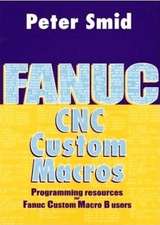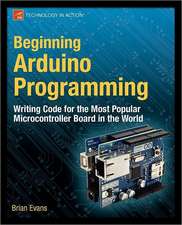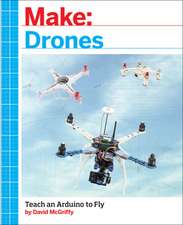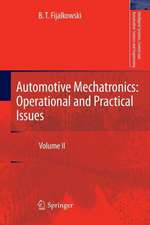Non-linear Control for Underactuated Mechanical Systems: Communications and Control Engineering
Autor Isabelle Fantoni, Rogelio Lozanoen Limba Engleză Paperback – 17 oct 2012
Din seria Communications and Control Engineering
- 15%
 Preț: 659.70 lei
Preț: 659.70 lei - 20%
 Preț: 879.74 lei
Preț: 879.74 lei - 18%
 Preț: 953.65 lei
Preț: 953.65 lei - 18%
 Preț: 1117.03 lei
Preț: 1117.03 lei - 9%
 Preț: 1385.77 lei
Preț: 1385.77 lei - 18%
 Preț: 1128.08 lei
Preț: 1128.08 lei - 18%
 Preț: 953.65 lei
Preț: 953.65 lei - 15%
 Preț: 656.89 lei
Preț: 656.89 lei - 18%
 Preț: 896.52 lei
Preț: 896.52 lei - 18%
 Preț: 1113.26 lei
Preț: 1113.26 lei - 18%
 Preț: 1388.22 lei
Preț: 1388.22 lei - 15%
 Preț: 647.27 lei
Preț: 647.27 lei - 18%
 Preț: 954.45 lei
Preț: 954.45 lei - 18%
 Preț: 1231.47 lei
Preț: 1231.47 lei - 18%
 Preț: 948.92 lei
Preț: 948.92 lei - 18%
 Preț: 1232.57 lei
Preț: 1232.57 lei - 18%
 Preț: 1127.28 lei
Preț: 1127.28 lei - 15%
 Preț: 643.34 lei
Preț: 643.34 lei - 18%
 Preț: 1401.30 lei
Preț: 1401.30 lei - 15%
 Preț: 651.51 lei
Preț: 651.51 lei - 20%
 Preț: 1454.07 lei
Preț: 1454.07 lei - 18%
 Preț: 948.79 lei
Preț: 948.79 lei - 18%
 Preț: 1233.06 lei
Preț: 1233.06 lei - 18%
 Preț: 947.85 lei
Preț: 947.85 lei - 18%
 Preț: 950.96 lei
Preț: 950.96 lei - 18%
 Preț: 956.99 lei
Preț: 956.99 lei - 15%
 Preț: 644.18 lei
Preț: 644.18 lei - 18%
 Preț: 946.87 lei
Preț: 946.87 lei - 18%
 Preț: 951.14 lei
Preț: 951.14 lei - 18%
 Preț: 961.55 lei
Preț: 961.55 lei - 15%
 Preț: 644.18 lei
Preț: 644.18 lei - 20%
 Preț: 990.80 lei
Preț: 990.80 lei - 18%
 Preț: 1006.72 lei
Preț: 1006.72 lei - 18%
 Preț: 942.44 lei
Preț: 942.44 lei - 18%
 Preț: 1233.06 lei
Preț: 1233.06 lei - 15%
 Preț: 641.85 lei
Preț: 641.85 lei - 18%
 Preț: 957.75 lei
Preț: 957.75 lei - 15%
 Preț: 649.87 lei
Preț: 649.87 lei - 18%
 Preț: 958.07 lei
Preț: 958.07 lei - 18%
 Preț: 1117.99 lei
Preț: 1117.99 lei - 18%
 Preț: 1395.94 lei
Preț: 1395.94 lei - 18%
 Preț: 781.62 lei
Preț: 781.62 lei - 18%
 Preț: 953.20 lei
Preț: 953.20 lei - 18%
 Preț: 1109.78 lei
Preț: 1109.78 lei
Preț: 388.90 lei
Nou
Puncte Express: 583
Preț estimativ în valută:
74.42€ • 79.58$ • 62.05£
74.42€ • 79.58$ • 62.05£
Carte tipărită la comandă
Livrare economică 18 aprilie-02 mai
Preluare comenzi: 021 569.72.76
Specificații
ISBN-13: 9781447110866
ISBN-10: 1447110862
Pagini: 308
Ilustrații: XI, 295 p.
Dimensiuni: 155 x 235 x 16 mm
Greutate: 0.44 kg
Ediția:Softcover reprint of the original 1st ed. 2002
Editura: SPRINGER LONDON
Colecția Springer
Seria Communications and Control Engineering
Locul publicării:London, United Kingdom
ISBN-10: 1447110862
Pagini: 308
Ilustrații: XI, 295 p.
Dimensiuni: 155 x 235 x 16 mm
Greutate: 0.44 kg
Ediția:Softcover reprint of the original 1st ed. 2002
Editura: SPRINGER LONDON
Colecția Springer
Seria Communications and Control Engineering
Locul publicării:London, United Kingdom
Public țintă
ResearchCuprins
1 Introduction.- 1.1 Motivation.- 1.2 Outline of the book.- 2 Theoretical preliminaries.- 2.1 Lyapunov stability.- 2.3 Passivity and dissipativity.- 2.4 Stabilization.- 2.5 Non-holonomic systems.- 2.6 Underactuated systems.- 2.7 Homoclinic orbit.- 3 The cart-pole system.- 3.1 Introduction.- 3.2 Model derivation.- 3.3 Passivity of the inverted pendulum.- 3.4 Controllability of the linearized model.- 3.5 Stabilizing control law.- 3.3 Stability analysis.- 3.4 Simulation results.- 3.5 Experimental results.- 3.6 Conclusions.- 4 A convey-crane system.- 4.1 Introduction.- 4.2 Model.- 4.3 Passivity of the system.- 4.4 Damping oscillations control law.- 4.6 Simulation results.- 4.7 Concluding remarks.- 5 The pendubot system.- 5.1 Introduction.- 5.2 System dynamics.- 5.3 Passivity of the pendubot.- 5.4 Linearization of the system.- 5.5 Control law for the top position.- 5.6 Stability analysis.- 5.7 Simulation results.- 5.8 Experimental results.- 5.9 Conclusions.- 6 The Furuta pendulum.- 6.1 Introduction.- 6.2 Modeling of the system.- 6.3 Controllability of the linearized model.- 6.4 Stabilization algorithm.- 6.5 Stability analysis.- 6.6 Simulation results.- 6.7 Conclusions.- 7 The reaction wheel pendulum.- 7.1 Introduction.- 7.2 The reaction wheel pendulum.- 7.3 First energy-based control design.- 7.4 Second energy-based controller.- 7.5 Simulation results.- 7.6 Conclusions.- 7.7 Generalization for Euler-Lagrange systems.- 8 The planar flexible-joint robot.- 8.1 Introduction.- 8.2 The two-link planar robot.- 8.3 Control law for the two-link manipulator.- 8.4 Stability analysis.- 8.5 Simulation results.- 8.6 The three-link planar robot.- 8.7 Control law for the three-link robot.- 8.8 Stability analysis.- 8.9 Simulation results.- 8.10 Conclusions.- 9 The PPR planar manipulator.- 9.1 Introduction.- 9.2 System dynamics.- 9.3 Energy-based stabilizing control law.- 9.4 Convergence and stability analysis.- 9.5 Simulation results.- 9.6 Conclusions.- 10 The ball and beam acting on the ball.- 10.1 Introduction.- 10.2 Dynamical model.- 10.3 The control law.- 10.4 Simulation results.- 10.5 Conclusions.- 11 The hovercraft model.- 11.1 Introduction.- 11.2 The hovercraft model.- 11.3 Stabilizing control law for the velocity.- 11.4 Stabilization of the position>.- 11.5 Simulation results.- 11.6 Conclusions.- 12 The PVTOL aircraft.- 12.1 Introduction.- 12.2 The PVTOL aircraft model.- 12.3 Input-output linearization of the system.- 12.4 Second stabilization approach.- 12.5 Third stabilization algorithm.- 12.6 Forwarding control law.- 12.7 Simulation results.- 12.8 Conclusions.- 13 Helicopter on a platform.- 13.1 Introduction.- 13.2 General considerations.- 13.3 The helicopter-platform model.- 13.4 Dissipativity properties of the 3-DOF model.- 13.5 Control design.- 13.6 Simulation results.- 13.7 Conclusions.- 14 Lagrangian helicopter model.- 14.1 Introduction.- 14.2 Helicopter model.- 14.3 Energy-based control design.- 14.4 Analysis and simulations.- 14.5 Conclusions.- 15 Newtonian helicopter model.- 15.1 Introduction.- 15.2 Modeling a helicopter using Newton’s laws.- 15.3 New dynamic model for control design.- 15.4 Lyapunov-based tracking control design.- 15.5 Analysis.- 15.6 Simulations.- 15.7 Conclusions.
Recenzii
From the reviews of the first edition:
"This is an application-oriented book that is intended for engineers, graduate students, and researchers who are interested in the design of nonlinear controllers for underactuated mechanical systems. … Non-linear Control for Underactuated Mechanical Systems is an excellent source for the development of control strategies for an important class of problems, viz, the underactuated mechanical systems. The book is clearly written, and the ideas are conveyed well by the authors. … It is strongly recommended for individuals and libraries." (SC Sinha, Applied Mechanics Reviews, Vol. 55 (4), 2002)
"This is an application-oriented book that is intended for engineers, graduate students, and researchers who are interested in the design of nonlinear controllers for underactuated mechanical systems. … Non-linear Control for Underactuated Mechanical Systems is an excellent source for the development of control strategies for an important class of problems, viz, the underactuated mechanical systems. The book is clearly written, and the ideas are conveyed well by the authors. … It is strongly recommended for individuals and libraries." (SC Sinha, Applied Mechanics Reviews, Vol. 55 (4), 2002)
Caracteristici
Will help the reader to gain experience in the modelling of mechanical systems and familiarise with new control methods for non-linear systems Deals with the application of modern control theory to some important underactuated mechanical systems














